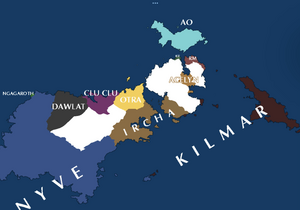Ircha
Enlightened Kingdom of Ircha Irčané Cgirxéwé Yhuzendekray | |
|---|---|
| Anthem: "Blog Yewa Hmi Mé" (Peace be to All the World) | |
Location within Solia | |
| Capital and largest city | Trinswon |
| Official languages | Irchan |
| Recognised regional languages | Dzo, Aoese |
| Ethnic groups (estimation) | Irchan, Aoese, Dzo |
| Demonym(s) | Irchan, Irchanic |
| Government | Ceremonial Monarchy with Ruling Aristocracy |
• Cat-King | Omayhi V |
• Regent | Honmajokka Cumré Nazlor |
| Legislature | Enlightened Court |
| Independent Nation | |
• Arrival of Irchanic people in the region | 600 BPL |
• First Unification | 553 PL |
• Myorzwo script is created | 1458 PL |
• Fifth (and last) unification | 2156 PL |
• Kuzoyzwo script is created | 2204 PL |
| Population | |
• 2391 PL estimate | 49 million |
• Density | 86/km2 (222.7/sq mi) |
| GDP (nominal) | estimate estimate |
• Per capita | 791 |
| HDI (estimation) | 0.29 low |
| Currency | Irchan Éri (Ɇ/IRE) (XAU = Ɇ261.29) |
| Date format | YYYY.MM.DD A.L. or P.L. |
| Driving side | right side of the road |
| Calling code | +98 |
| Internet TLD | .ir |
Ircha, or the Enlightened Kingdom of Ircha (Irchan: Irčané Cgirxéwé Yhuzendekray [irt͡ʃane t͡sɡ̊irʃeβe ʒud̥͡z̥əŋd̥əkraɪ̯]) is a country located on the continent of Solia. It does not border any other country currently. Trinswon is the capital and largest city, although the traditional royal capital is the city of Cukki. Two other populous cities are Yhočard and Hakmehximéy.
The country is split up into 5 regions, which are Abkezdekray, Pzasunoyhog, Uobamoyhog, Myamonsan, and Hwiyhésan. Each region is split into multiple prefectures.
Ircha has been inhabited by ethnic ancestors of the modern Irchans since roughly 600 BPL. Historically, Ancient Ircha was split between different clans. Some had their own cat-chiefs while some just had a human leader. The first time that the entire country was unified, by the Kmoruo clan, was during the mid 11th century. That was when the First Kingdom was formed, and the first Cat-King was Sunya I. It started the dynasty of Cat-Kings which continues to this day. Because of how large the country was getting, a writing system was developed for divination and for sending messages, especially to troops at the frontline. However, it split apart again in the late 12th century, although the Cat-King dynasty remained in power in the imperial capital of Cukki. A few more cycles of uniting and breaking apart happened, and through it all Cukki was always ruled by the Kmoruo clan, who defended the city fiercely. The current Kingdom, the fifth one, was united in the 20th century PL.
History
Prehistory
Ircha was first inhabited by Irchans in 600 BPL. However, there exists evidence of an earlier culture likely related to the modern Dzo culture, which has spread all around central Solia. Their earliest artifacts though, only date back to about 800 BPL. They were rapidly overtook by the Irchans who started to create a decently advanced civilisation in the area.
Traditionally, it is told that long ago the humans a species of cats built a civilisation in roughly the land which is now Ircha. When people came, though, they ridiculed the cats and saw themselves as superior to them. The cats tried to fight back, but the humans brutally exterminated every cat that they could find in the area. Fortunately, a small group of cats managed to escape but they couldn't build back up any kind of advanced civilisation. For a few generations, the cats waited in the mountains before sending some messengers back. They pleaded to the humans to let each other live in peace, but most of the humans declined the offer and decided to cook the envoys to eat in a feast. A few people, though, helped some of the messengers escape and went to aid the cats in taking back their land. Over time, the members grew and grew until in a dashing attack they kicked the cat-hating humans out. The cats were merciful and allowed the humans to live and prosper, as long as they didn't try to bully the cats again.
Ancient
The First Kingdom was officially established in 553 PL. Much like modern-day Ircha, it had a Cat-King as the de jure ruler and a Regent elected by the people as the de facto leader. During its time, writing was first invented as a primitive logography known as the Kortuzwo script. It grew to take up most of the coastal areas of Western Ircha, though never quite took control of the mountains or Eastern Ircha. Its capital was the now-abandoned town of Hyorkrad.
In 992 PL, the heads of various clans in Ircha famously invited the Regent to a feast to celebrate the Irchan New Year. They managed to get the Regent considerably drunk, and made him sign a contract which allowed the clan heads to have their own land independent of the Regent. When he got to his senses the next morning, it was too late. This marked the beginning of the Warring States Period, when as many as up to 11 different clans were all fighting over land in Ircha.
It was only until 1203 PL that the Kmoruo clan regained control over the entire country, expanding the land of Ircha to include some of the mountains where the Dzo people lived. Unfortunately, they would not last for even a century before collapsing again. Similar to the previous Warring States period, many clans raced to claim land for their own, but one clan happened to have the most power; the Uju clan. It would only take until 1300 PL to conquer all of the other clans. The Uju Dynasty was one of the few clans in Ircha to not have a cat as the de jure ruler, instead having a typical dynasty of human absolute monarchs with a court of advisors. They were not very popular, and kept a tyrannical iron grasp on the nation.
Classical
It only took until 1422 to break apart, with some help from Lichrene. The main clan participating in this overthrow was the Myalhwa clan, who made many efforts to obtain close ties with Lichrene. However, they were not able to keep the country together and four clans came to have direct rule over land in Ircha; Pzasun, Myalhwa, Hkan, and Kmoruo. The most powerful clans during this period were the Pzasun and Myalhwa clans, both being highly respected and having lots of land. Despite being split between different clans, many advances in science and language were made, most noteably the invention of the Myorzwo script by Myalhwa scribes.
They were all in a state of relative stalemate during the time, though, and it took until 1593 for the Myalhwa clan to take over the Kmoruo and Pzasun clans. It seemed to most people that the Myalhwa clan would unify Ircha, but in an unexpected turn of events, the underdog Hkan clan won the crucial Battle of Lomoynyé in a brilliant show of their innovative strategy. They were able to eliminate many of the Myalhwa clan's troops, and the head of the clan, Étsou Piji Myalhwaagi, became so ashamed that he committed ritual suicide. The Myalhwa court was scrambling to reorganise and find a new head, so the Hkan troops easily sweeped through their land to their capital, Huknoy, forcing them to surrender. This marked the beginning of the longest period of Irchan history, lasting 497 years from 1601 to 2098 PL. The Hkan court was relatively popular among the Irchan people, and the country grew and prospered in many different ways. During this era, in the mid-18th century PL, the Lichrene queen Mailheache II came to spend a few years in Ircha to strengthen ties and learn about Irchan culture. She and Frilliceau culture became very popular amongst Irchan people at the time and many words from the Frilliceau language came to be borrowed into the Irchan language.


